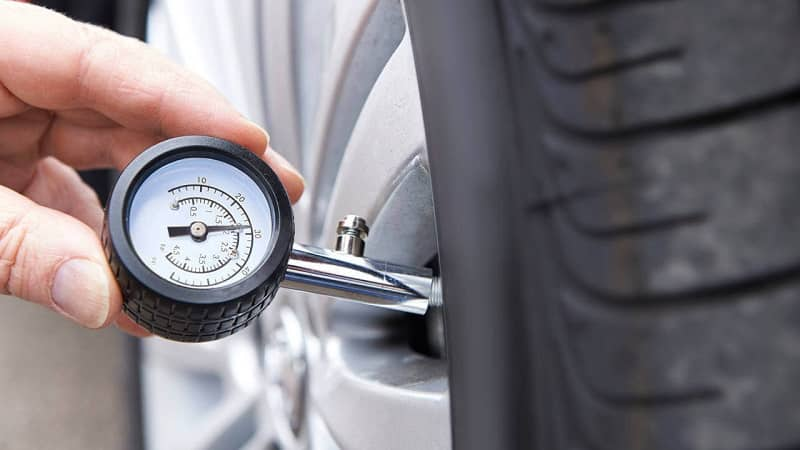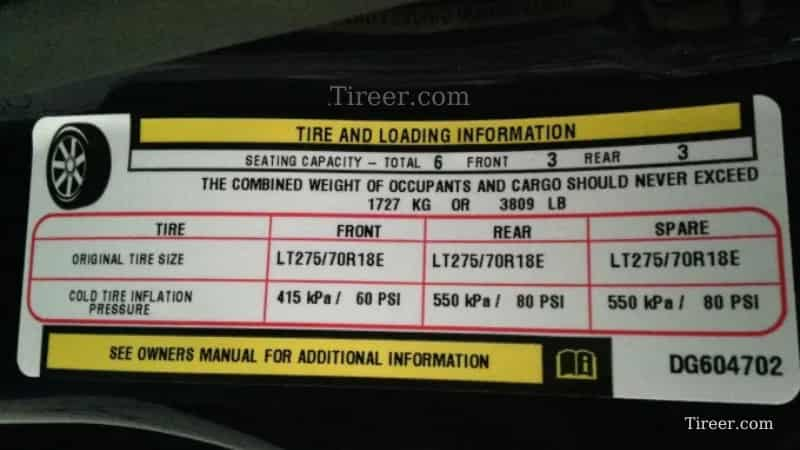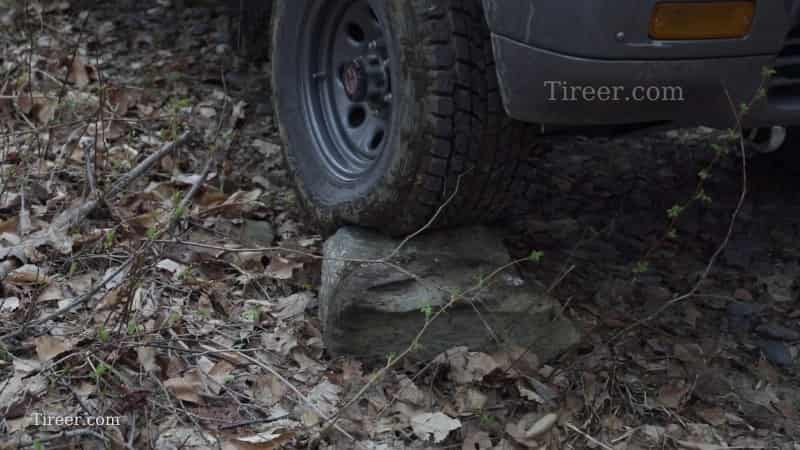When it comes to driving safety, tire pressure is always one of the hottest topics. Why does tire pressure matter? What the heck is that little annoying symbol on my dashboard? Should I under-inflate my tire during the winter? How often should I check my tire pressure?
We got tons of questions like this from our community, so for today, let’s dive deep into the world of tire pressure, put our geeky glasses on and figure out everything you need to know about your tires.
1. What’s The Recommended Tire Pressure For My Car?

The recommended tire pressure varies based on the vehicle makes determined by the manufacturer after thousands of tests and calculations. For most vehicles, you can find the ideal tire pressure on the sticker/card inside the driver’s door for newer cars. If there’s no sticker, you can usually find the info in the owner’s manual. Normal tire pressure is usually between 32~40 psi(pounds per square inch) when they are cold. So make sure you check your tire pressure after a long stay and usually, you can do it in the early morning.
2. How To Check The Tire Pressure?
- A Tire Pressure Gauge(Digital or Regular)
- Vzduchový kompresor
- Pen and paper / your phone
Step 1: Test with cold tires
As tire pressure changes with the temperature a lot, and recommended tire pressures are cold inflation pressure , you should start with cold tires if possible. We mostly check the tire pressure after one night’s rest to avoid the heat from the friction of the last drive, and before the temperature goes up.
Step 2: Check the tire pressure with the gauge
Unscrew the valve cap and press the tire gauge onto the valve stem hard enough until the hissing sound disappears. There should be a reading as long as the gauge is well connected to the tire.
Step 3: Note down the readings
You can then note down the tire pressure of each tire, and compare them with the ideal psi you read from inside your driver’s door or in the owner’s manual. Make sure you read in detail, as for some vehicles, front and rear tires have different recommended psi.
Step 4: Fill your tires to the recommended psi
If you find a tire underinflated, use the air compressor to fill your tires. You can either buy an air compressor in the auto parts store or use one in a gas station. Remember to rest your tires for at least half an hour to make sure they’re cold and the reading is accurate. If you have to fill your tires when the tires are hot, inflate them 3~4 psi above the recommended psi, and check again with your gauge when they are cold. It’s ok to overinflate a bit when filling the tires, as you can let the air out with the gauge.
Step 5: Check the tire pressure again
After filling the tires, use your tire pressure gauge to check the tire pressure again and make sure they are in a good range. Let the air out a bit if they are over-inflated by pressing the gauge harder on the valve stem.
3. How To Maintain Proper Tire Inflation?
Tire maintenance is essential for the overall performance of your vehicle, and we highly recommend that you check your tire pressure every time you inflate your tire, each 10°F (5.6 °C) temperature change, and every 30 days.
Be mindful that don’t wait until the TPMS(Tire Pressure Monitoring System) light come on before you check the tire pressure, as the normal TPMS may:
- Turn on after the tire pressure is well underinflated
- Cannot detect gradual air loss
- Cannot detect over-inflated tires
- Cannot tell which tire is under-inflated
- Cannot turn on if the TPMS is not transmitting the signal to the dashboard
- .
For more information about the tire pressure monitoring system, please check our post about TPMS: What is TPMS and Why Does it Matter?
Thus, we highly recommend that you check your tire pressure regularly, especially before a long drive or heavy load driving. Also, temperature affects the tire pressure a lot, and we will explain it in the next section.
4. How Does Temperature Affect Tire Pressure?
First of all, the rule of thumb is for each 10°F (5.6 °C) decrease in temperature, the tire pressure will drop by one psi for most passenger vehicles. When it comes to commercial truck tires, which are often inflated to over 80 psi (twice as much as a passenger vehicle tires), the change of tire pressure according to temperature is doubled to 2 psi for every 10°F.
For the non-nerdy readers, just remember this rule of thumb and keep in mind that you will need to monitor your tire pressure during different seasons or a sudden temperature change. For those who want a deeper dive into how psi’s are determined, here’s the science behind it.
The equation we use to calculate the relationship between tire pressure and the temperature is called the Zákon o ideálním plynu. It is a good approximation of the behavior of many gases under many conditions. ( Appx1 ) It works well for most low-pressure gases. When applied to tire pressure calculation, the error is less than 1%.
First, we take the Ideal Gas Law equation and apply it to our circumstance:
PV = nRT
kde,
P = absolute pressure
V = gas volume in the tire
n = the number of molecules of gas in the tire
R = universal gas constant
T = teplota
Since we are trying to examine the pressure change according to the temperature, let’s assume two tire pressures P1 a P2 at their set temperatures T1 a T2.


Vzhledem k tomu n a R are both constants, and the gas volume in the tire is also a constant, we can take those constants out of the equation, and suddenly we get this straightforward one:

Let’s say the temperature drops from 100°F to 50°F, the tire pressure at 100°F is 35 psi, so what’s the tire pressure now at 50°F?

(the metric system is getting in the way, huh?)
Absolute Pressure = tire pressure + sea level air pressure (14.7 psi). So,

Put all that into the equation,

So a 50°F drop in temperature lowers the air pressure by 4.5 psi, which is pretty much the same according to our rule of thumb.
5. How Does Tire Pressure Affect Driving
Both overinflation and underinflation affect your tire performance a lot, and serious problems might occur. According to NHTSA(National Highway Traffic Safety Administration), driving on underinflated tires increases a driver’s chance of being in a serious accident by 300%. So how will a bad tire pressure affect driving safety? We will explain in detail below.
How tire pressure affects grip
The grip is mostly associated with the size of the contact patch between the tire and the road. An over-inflated tire radically decreases the contact patch while an under-inflated tire does the opposite.
A larger contact patch gives you more grip, and this is the exact reason why lots of racers will intentionally decrease their tire pressures to create a larger contact patch on a dry race track.
However, despite the fact that an under-inflated tire will cause more fuel consumption and improper tear and wear of the tires, for most daily commuters, it might cause an even scarier problem, which is hydroplaning.
Hydroplaning is a hazardous event when a layer of water builds between the wheels and the road surface, leading to a loss of traction that prevents the vehicle from responding to control inputs. (Appx2)
Hydroplaning occurs when the pressure of the tire pushing on the ground is equal to the water pushing back up on that tire. The size of the contact patch, given the force or the weight of the tire, is the same, directly affects the average pressure the tire’s putting down on the road. The larger the contact patch (by deflating the tires), the less pressure it puts on that same area. So there’s a causal relationship between your tire pressure and the possibility of a hydroplaning event.
Here’s a more visual explanation of what is happening between a properly-inflated tire and an underinflated tire when driving on a wet road.
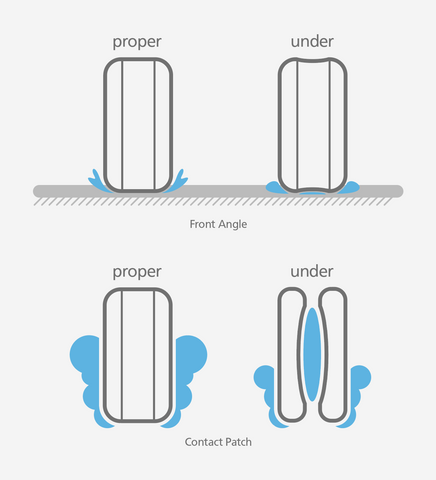
(waters could easily go under an under-inflated tire and cause hydroplaning)
To avoid a hydroplaning event, ALWAYS inflate your tires properly. Also, check your tires’ treads, which make the water flow around the tires more efficiently, and of course, driving slow is always a big plus.
How tire pressure affects tire wear
The contact patch directly decides the pattern of the tire’s wear and tear. You don’t want your tires to wear out prematurely just because you have an over or under-inflated tire.

How tire pressure affects fuel economy
Imagine you are a ball rolling on the ice, there’s no friction between the two surfaces, how much extra force do you need to apply to keep the ball moving? Zero (Thanks, Newton). The same applies to your fuel consumption when it comes to driving on the road. The rolling resistance between your tires and the road significantly affects fuel economy, and by now we should all know the logic behind this, lower tire pressure leads to a larger contact patch, which causes higher rolling resistance, and thus, poor fuel economy.

A Michelin study showed that your tire is accountable for at least 1/5 of your total fuel consumption and a 1-bar of pressure drop (14.5 psi) would increase your fuel consumption by 3-5%.
6. Special Conditions For Tire Pressure Manipulation
There are of course circumstances where you want to manipulate your tire pressure to meet specific requirements. Like the aforementioned track race, or if you are driving on sand, mud, etc. However, as a daily commuter, we strongly suggest you regularly check your tire pressure, preferably once a week and anytime you might take a long road trip, and always keep the tires properly inflated!
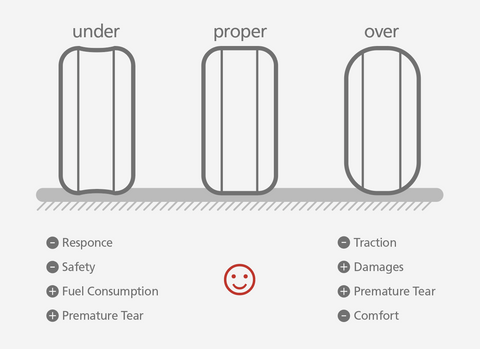
(overview of tire properties under different pressure points)
Proč investovat do čističky vzduchu?
Tire pressure is always a hot topic regarding driving safety, and it’s important to keep an eye on the tire pressure to maximize fuel efficiency and safety.
Než půjdeš
We’d like to offer you our most popular ZUS Smart Vehicle Health Monitor for FREE to better take care of your car and save $$$ on car expenses. Claim your free unit here.

Nejlepší příspěvky od nonda:
You’ll find too many opinions on the correct tire pressure for your car online, but also in real life. For instance, when I was at the tire shop for the last summer-to-winter tire change, the technician advised me to underinflate the tires a bit because it would make the car more comfortable.
I drive a 2021 Corolla Hatchback (European model), and Toyota recommends 2.5 bar (36 psi) on an unloaded car and up to 2.8 bar (40 psi) with cargo and passengers inside. Yet, the technician said 2.2 bar (32 psi) would be more appropriate for my car.
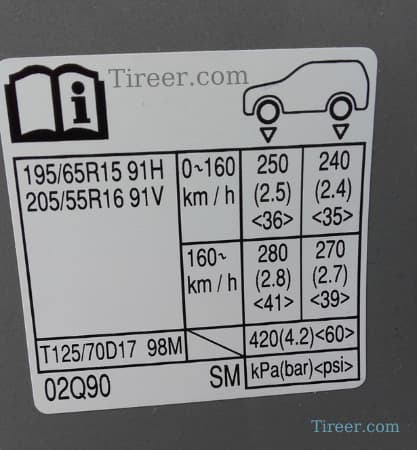
Recommended tire pressure on my 2021 Toyota Corolla Hatchback
Now, I know a thing or two about tires and told him to inflate them to the manufacturer’s recommended pressure. But Toyota knows even better than the technician or me, and the same is true for every other vehicle manufacturer.
Automakers test their vehicles to the limit for thousands of miles and at various loads to find the perfect tire pressure. In other words, the manufacturer (in this case, Toyota) designed the suspension to work optimally at a tire pressure of 2.5 bar (36 psi) and give me a smooth ride while also remaining stable at high cornering speeds. The higher pressure also significantly reduces fuel consumption and emissions, which is not insignificant.
I never had issues with the ride being choppy at the recommended pressure. Actually, I tried underinflating them to 2.2 bar (32 psi), and the ride didn’t improve much, yet the car was much less agile in the corners. Besides, I immediately saw the fuel economy go down, and I’m sure the tires wore faster for those couple of days.
But should you go higher? Je 40 psi dobrý tlak v pneumatikách? It depends on the car, of course, since some manufacturers recommend such pressures. But let’s dig deep into the tire pressure rabbit hole since there is much more to discuss here.
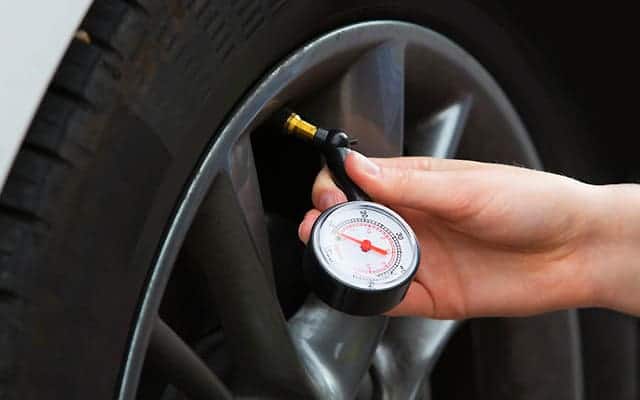
- 40 psi vs. Other Tire Pressures
- 1. Lower than 40 psi
- 2. At 40 psi
- 3. Higher than 40 psi
40 psi vs. Other Tire Pressures
40 psi (2.8 bar) sits at the highest end of what you’d consider normal tire pressure in hatchbacks, sedans, crossovers, small and mid-size SUVs, and sports cars.
However, 40 psi is actually low for heavy-duty trucks like the Ford F-350 and Chevy Silverado 3500, which need load range E tires inflated to 80 psi to carry all that heavy cargo. So, it really depends on the model, which is why you should always inflate your tires upon the manufacturer’s recommendations.
Still, you could play with the tire pressure a little in order to find the perfect blend of performance, comfort, and fuel economy. Generally, you should always inflate your tires to 40 psi (or higher) when you load your vehicle, like, for example, before going on a summer vacation. But let’s have a look at other reasons why you would want to do that:
![]()
1. Lower than 40 psi
![]()
Lower than 40 PSI
Most passenger vehicles today come with recommended tire pressures of under 40 psi for an unloaded vehicle (one to two passengers). Thus, it’s completely normal to drive with tires at, say, 32 psi or 36 psi, as the manufacturer tested the vehicle excessively and found that these values work best with the particular model.
Still, lower pressures than 40 psi will generally give you a softer ride, which you can especially feel if the roads in your area are of a low quality. Moreover, you can expect higher traction on snow and ice and on some off-road terrains, like deep mud or large rocks.
Nonetheless, tires with less than 40 psi, or lower than the manufacturer’s recommended pressure, will wear down faster. On top of that, it increases the chance of damage from impacts, like potholes or curbs, as there won’t be enough air to support the other internal components of the tire.
But the biggest changes will be worse performance and fuel economy due to higher rolling resistance and less agile handling. You’ll feel these things almost immediately after you lower the pressure inside your tires.
There is also one very important factor to consider – tires with lower than 40 psi more easily. Namely, due to the lower pressure, the tire won’t be able to cut through puddles of water as easily and will float over, which can dramatically destabilize your vehicle, even when driving in a straight line. Hence, it’s crucial to always keep your tires properly inflated.
Remember, though, all of these things are only true if the manufacturer recommends 40 psi tire pressure on its vehicle. For example, the minimum tire pressure on the Tesla Model S is 40 psi since it’s a heavy electric vehicle with staggering performance, but regular gas cars usually need lower pressures.
![]()
2. At 40 psi
If the manufacturer recommends 40 psi on your car, it would be the perfect middle ground between performance, comfort, tread wear, and fuel economy. Most EVs today come with recommended pressures of around 40 psi for longer range, but also increased low capacity, as they are heavier than regular vehicles.
However, if the manufacturer recommends lower than 40 psi, you risk worse ride comfort, increased wear on the center of the tread, and less grip. However, you’ll also gain in efficiency – the higher the pressure, the lower the rolling resistance.
Hence, it’s popular among some drivers, particularly of hybrid vehicles and EVs, to inflate the tires to 40 psi for higher MPGs or a longer range, although manufacturers recommend lower pressures. Still, beware that going higher than the manufacturer-recommended tire pressure will hurt rain and snow traction.
![]()
3. Higher than 40 psi
Going higher than 40 psi will further reduce the rolling resistance of the tires and increase fuel economy/range. Moreover, it should reduce overall tire wear, though the center of the tread will wear faster than the outer edges.
You’ll also experience quicker responses from the tires when you turn the steering wheel, along with more agile handling and better hydroplaning resistance. Since there is more air inside the tire, it can now carry higher loads, which is why many heavy-duty trucks come with 40+ psi recommended tire pressures.
But if the manufacturer doesn’t recommend going higher than 40 psi, there is no point in doing that. For starters, the ride will be much less comfortable, and you’ll experience a much worse grip on snow and ice. Moreover, the tires will wear unevenly, and there is a higher chance of blowout due to the increased pressure.
![]()
What’s the Recommended Tire Pressure for my Car?
Every vehicle comes with a different recommended tire pressure. Automakers decide on this pressure by doing extensive tests and also make it work with the suspension.
For instance, some sports cars, like the Mazda MX-5 Miata, have a recommended pressure of 29 psi (2.0 bar) because the suspension is already firm, and the tires need to soak up road imperfections. Meanwhile, a Chevy Silverado 3500 has a recommended pressure of 60 psi (4.1 bar) for the front tires and 80 psi (5.5 bar) for the rear tires because it’s a heavy-duty truck that carries heavy loads.
![Recommended tire pressure on Chevy Silverado 3500]()
Recommended tire pressure on Chevy Silverado 3500
With that said, you can find the correct tire pressure for your vehicle on the tire pressure label, which is located on the driver’s door jamb, inside the fuel filler flap, or in the glove compartment. The label will display the recommended tire pressure for both front and rear tires under various load conditions.
If you can’t find the placard, you can refer to your vehicle’s owner’s manual, where you can also find the correct pressure for various loads.
Before measuring the tire pressure on your tires, though, it’s good to let them cool down, especially if you drove for longer than 1 mile (1.5 km). Tires get hotter as they roll down the road, which increases the pressure inside – you’ll get a 1-psi (0.07 bar) higher reading for every 10 °F (5.5 °C) increase in temperature.
Also, tire pressure changes with elevation, so when you are climbing a mountain, you’ll notice the tire pressure increasing by 1 psi for every 2,000 feet (610 meters) of elevation gain. So, take that into consideration before deciding to inflate/deflate the tires.
![]()
How to Check Tire Pressure?
Checking the tire pressure is a very simple operation that every driver can and should know how to do. All you need is a tire pressure gauge. I prefer the newer digital ones since they are easier to read, especially for people with bad eyesight, but they also give more accurate results. These gauges are very small and won’t take space in your trunk, and are also very cheap, so it’s good practice to have one in your vehicle.
- Wait for the tires to cool down; remember, hotter tires will show higher pressure readings! If you drove the vehicle for more than 1 mile (1.5 km), you should wait for at least 30 minutes before the tires cool down, but longer if you drove for more than 10 miles (15 km).
- Check the recommended tire pressure on the placard or in your vehicle’s owner’s manual – it should be similar for the front and rear tires, but in some cases, it will be different. Also, take into account the load in your vehicle (passengers and cargo);
- Remove the plastic valve cap on the wheel by unscrewing it and setting it aside in a safe place, so you don’t lose it;
- Place the tire pressure gauge on the valve stem and make sure it seats properly with no air escaping. Most gauges have locking clips, which you can use to lock them onto the stem. You should get the correct reading after a few seconds on the digital gauge, but analog models will show it immediately.
- Please make sure you read the gauge correctly – most have the option for imperial (psi) and metric readings (kPa and bar). Usually, if you live in North America, you’ll want to look at the «psi» numbers, while people outside the continent will want to look at «bar»;
- Inflate/deflate the tires if necessary. For this, you’ll need a tire inflator kit, which is also nice to have in your car. However, you can use the tire inflator at every gas station for free;
- Once you are done reading/inflating the tire, make sure to reinstall the valve cap, as it will keep debris from entering inside.
Video created by GeoBeats Science
Ztrácejí pneumatiky časem tlak?
![]()
All tires lose pressure over time due to air permeation through the rubber, valves, or uneven tire bead. How much pressure they will lose depends on how well the tire sits on the rim, but also the age and quality of the tire.
On average, tires lose 1-4 psi (0.1-0.3 bar) of pressure per month, and that is only if the temperature outside is relatively stable. However, larger temperature changes can affect the tire pressure more significantly; As a rule of thumb, tire pressure decreases by about 1 psi (0.07 bar) for every 5.5°C drop in temperature.
Therefore, it’s crucial to check the tire pressure at least once a month and at every sudden temperature drop/increase.
![]()
Changing Tire Pressure When Carrying Heavy Cargo
Carrying heavy cargo will increase the load on the tires, and they won’t be able to provide you with safe handling and grip. That’s because the tire would warp when accelerating, cornering, or braking, which dramatically decreases the vehicle’s performance. Hence, it’s essential to increase the pressure to accommodate the additional load.
You can find all the information you need on the tire pressure placard or inside the owner’s manual. Automakers usually provide a base tire pressure for 1-2 passengers in the vehicle, middle tire pressure for four passengers, and the highest reading is usually for a fully-loaded car with five passengers and their cargo.
![]()
Can You Manipulate Tire Pressure for Track Driving or Off-Roading?
![Lower the tire pressure when off-road driving]()
Lower the tire pressure when off-road driving
Yes, changing the tire pressure can dramatically improve your vehicle’s performance on the track and also when off-roading.
On the track, you’ll probably want to go with a slightly lower tire pressure than the manufacturer’s recommended 40 psi. This is mainly because by driving your car hard (acceleration, braking, and cornering), you’ll get those tires hot, which would increase the pressure even further. That would decrease the contact patch, limiting grip and overall performance.
Hence, it’s essential that you compensate for the increase in temperature. But how much psi below the manufacturer’s recommendations should you go? Honestly, you can only find out by testing with various pressures – that’s one of the beauties of driving on the track. In my experience, if you only need to do one hot lap, you can go for a slightly higher pressure, but prolonged sessions might require lower pressure.
As for off-roading, you’ll usually want to lower the pressure when driving on very challenging terrains like deep mud, sand, or large rocks. On sand and mud, you’ll want the tire floating over the surface, as otherwise, you might get stuck. Lower tire pressure will help you do that by increasing the contact patch, which distributes the vehicle’s weight more evenly. As for large rocks, lower tire pressure will help the rubber conform over them and give you traction.
Still, a tire with higher pressure will give you more traction on dirt and gravel since it will concentrate the vehicle’s weight into the ground. The same is true for shallow mud, where you can’t get stuck but need the added traction. Like with track driving, you’ll want to experiment with the pressures and see which one works best for your scenario.
Also, keep in mind that driving at very low pressures can damage the tires. As a result, many off-roading enthusiasts use beadlock wheels, which lock the tire’s bead into place and don’t let it come out of the rim, even when fully deflated. They are expensive but can be very helpful if you are into hardcore off-roading.
To prevent tire failure, you should assess the TPMS alert as soon as possible. In this case, TPMS tools will be your assistant to diagnose and fix the defective problems of your vehicle.
![]()
Proč investovat do čističky vzduchu?
Incorrect tire pressure is a serious safety concern, yet only a few drivers check their tires every month. But even if you don’t do that about safety, do it for your pocket – underinflated tires wear more quickly, meaning you’ll need to replace them sooner, while overinflated tires wear unevenly, which also warrants an earlier replacement.
Hence, I implore drivers to look after their tires and regularly check the pressure, but also irregularities on the tread and sidewall (wires and bulges showing). That way, you’ll ensure your and the safety of other traffic participants, but also save money in the long run!
![Ivo Gievski]()
Jsem Ivo Gievski, autor obsahu pro Tireer. Naše webové stránky jsme vytvořili s více než 15 lety zkušeností a rozsáhlým výzkumem v automobilovém a technologickém sektoru. Moje odhodlání poskytovat vysoce kvalitní obsah je neochvějné a neustále se snažím zdokonalovat své dovednosti, abych si udržela náskok před trendy v oboru a poskytovala čtenářům informativní, poutavé a cenné poznatky.

